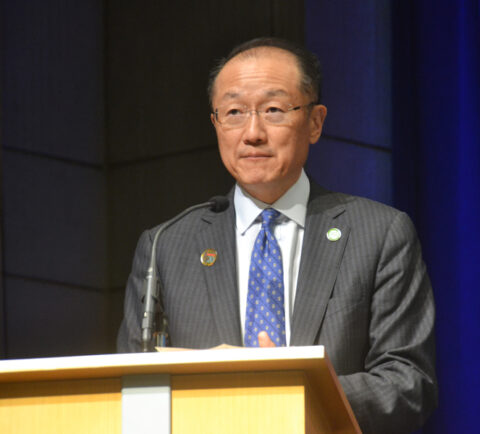Faith Nwadishi has heard it all before when it comes to promises to end the routine flaring of natural gas that is associated with oil production. Nwadishi, a resident of Nigeria’s oil-rich Delta State, said that although her country approved a law in 1979 to end gas flaring, the routine flaring continues.

Communities near the flaring sites “don’t know the difference between day and night because they go to bed with active gas flare sites,” said Nwadishi. She is the national coordinator in Nigeria for Publish What You Pay, a nongovernmental organization focusing on transparency in extractive industries. “Women go to gas flare sites to dry their fish and sell to the people without knowing the implications of what they are doing.” She added that “gas flaring is a threat to my fundamental right to life because gas flaring hampers my right to a clean environment and gas flaring is evil.”
Nwadishi was one of the featured speakers at a 17 April event at the World Bank in Washington, D. C., to launch a new initiative to end the routine flaring of natural gas by 2030. Flaring is a widely used practice to dispose of natural gas, particularly when there is a lack of infrastructure to use the gas productively.
Nwadishi said she was pleased that 25 countries, companies, and development institutions, which together are responsible for more than 40% of global gas flaring, already have committed to the initiative. However, she said, the commitment needs to be translated into action to help communities affected by pollution from gas flaring.
Health and Environmental Issues Related to Gas Flaring
Gas flaring can emit a number of hazardous substances that can affect public health, including carbon monoxide, which can cause respiratory problems; benzene, which is carcinogenic; and volatile organic compounds, which help to create ground level ozone and can induce nausea and breathing difficulties. According to the World Bank, “There is, however, little definitive data as to how proximity to flares, duration of exposure, etc. are linked to actual health problems as few studies of the health impact of flaring have been carried out.”
In addition to health threats posed by the approximately 140 billion cubic meters of natural gas routinely flared each year from thousands of oil fields around the world, the flaring also pumps about 350 million tons of carbon dioxide (CO2)—nearly 1% of total CO2 emissions in 2013—into the atmosphere and contributes to black carbon, which affects the radiation balance in the Arctic, according to the World Bank.
That flared gas adds emissions equivalent to that of about 77 million cars, according to bank spokespeople. Moreover, if the gas were used for power generation it could provide 750 billion kilowatt hours of electricity, more than what is currently used in all of Africa, the bank noted.
The initiative, Zero Routine Flaring by 2030, calls for endorsers to commit to no routine gas flaring at new oil fields and to work as quickly as possible—no later than 2030—and to identify solutions to end routine flaring at existing oil production sites. Initial endorsers of the initiative include 9 countries, 10 oil companies, and 6 development institutions.
Of the countries endorsing the initiative, two, Russia and Kazakhstan, are among the eight largest flaring countries; together, those two account for more than 65% of total flaring, according to satellite data estimates from 2012 cited by the World Bank. The other six large emitters are Nigeria, Iran, Iraq, the United States, Algeria, and Venezuela. The initiative recognizes the distinction between routine flaring and flaring that may need to be done for safety or production protocols.
Routine Flaring “Must Come to an End”
Jim Yong Kim, president of the World Bank Group, said the wasteful, routine flaring of natural gas “must come to an end.” He said, “These flares represent inaction, and a stark reality that millions of people go to sleep each night lacking basic energy resources, while a valuable resource that could provide the energy goes up in flames, often just a short distance from their homes.”
Kim added, “This is unsustainable and unacceptable, particularly because we know we can build the infrastructure and apply existing new technical and regulatory frameworks and sound energy policies to harness this resource and put it to productive use.”
He said that with the United Nations climate summit in Paris later this year, the flaring initiative “will stand as a tangible contribution to reducing global CO2 emissions.”
Ban Ki-moon, secretary-general of the United Nations, said that gas flaring “seems to be a symbol of prosperity and wealth” but that the wasted gas could be used more beneficially. Ban said he is looking to the business community and to scientists to help find ways to reduce wasteful flaring and enhance energy efficiency.
Flaring and Black Carbon
Børge Brende, Norway’s minister of foreign affairs, said that his country banned gas flaring from the outset. “Since routine flaring is not an option, industry has had to work creatively. The associated gas is being used, and it increases our productivity.”
Brende added that gas flaring causes 40% of the black carbon in the Arctic. “We know that gas flaring in the Arctic is especially harmful. Black carbon from gas flaring settles on Arctic snow and sea ice, darkens the surface, and accelerates the melting of the ice,” he said.
Menahi Al-Anzi, deputy CEO for the exploration and gas directorate of the Kuwait Oil Company, said that since the country’s gas flaring reduction program began in 2005-2006, flaring has been reduced from about 17% of total gas production to 1.1%. Al-Anzi told Eos that his message to others who have not yet endorsed the World Bank’s initiative is that the initiative “is really about human beings’ lives, their health, their power generation. It is really humanity more than just economics, so people need to look at this from this side.”
Hurdles to Overcome
Several oil company executives also attended the World Bank’s launch of the initiative. They included Jorma Ollila, chairman of Royal Dutch Shell, which has endorsed the initiative. Ollila said that for the initiative to be a success, more parties must sign on, particularly more countries where flaring takes place. He added that stakeholders have to stick together in the campaign to end routine flaring.
“You need alternate ways to use natural gas produced with oil. You need facilities to capture gas, pipelines to support it, and customers to sell it to.”
“You need alternate ways to use natural gas produced with oil,” Ollila said. “You need facilities to capture gas, pipelines to support it, and customers to sell it to. Infrastructure and markets can’t be built by governments, companies, or development organizations alone. It requires partnerships.”
Eldar Sætre, CEO of Statoil, added that his company believes that meeting the target of zero routine flaring by 2030 “is one of the most important contributions that our industry can make toward mitigating climate change.”
Solomon Asamoah, vice president for infrastructure, private sector, and regional integration at the African Development Bank, told Eos the hurdles to involve more companies in the initiative include publicity and pressure. “I am a firm believer that lecturing and trying to get companies to do ‘the right thing’ on [their] own is not powerful enough. You have to have legislation or you have to have financial incentives or financial disincentives for them to adopt these kinds of behaviors. So it’s a joint thing between the governments and the private sector. But I think the regulatory issues, the legal issues that govern investment in oil and gas, are where the issue needs to be addressed.”
A Complicated Mix
Kandeh Yumkella, CEO of the UN’s Sustainable Energy for All Initiative, said that Africa should be the leader on the issue of ending routine gas flaring. Yumkella, who has been instrumental in pushing the initiative, said the wasted gas could provide energy for the 620 million Africans who currently lack access to electricity.
He added that in the past 5 years, 30% of new oil and gas discoveries have been in Africa. “We have no business being energy poor,” Yumkella said. “Our dream is the following: We go to Paris and everybody has signed” the initiative.
He told Eos that the initiative is doable and that technology is not the limiting factor. “First of all, you need markets,” he said, noting that there need to be enabling conditions to provide incentives for investment in infrastructure, including gas pipelines, power plants, and transmission lines. Another key issue is pricing. “So it’s a complicated mix of public policy and also incentives to get the investments in.”
Anita Marangoly George, senior director of the World Bank Group’s energy and extractives global practice, told Eos that there are already indications that other parties will sign onto the initiative. However, she noted that investments toward reducing flaring are not cheap.
“These companies who are signing up are therefore committing that wherever in the world they are where they have oil fields—both existing as well as green fields—they are going to live up to this commitment,” she said. “That’s an incremental investment for which, of course, we believe there are huge environmental, social, and economic returns.”
However, “On an individual company basis, they are a little bit in the dark, because once they capture this gas they have to figure out [if they can] use it economically so they get the return of the investments.” George said. “So that’s why [the issue] has been more difficult.”
—Randy Showstack, Staff Writer
Citation: Showstack, R. (2015), Initiative aims to end routine flaring of natural gas, Eos, 96, doi:10.1029/2015EO028847. Published on 24 April 2015.
Text © 2015. The authors. CC BY-NC 3.0
Except where otherwise noted, images are subject to copyright. Any reuse without express permission from the copyright owner is prohibited.


